One of the benefits of living in San Diego is the opportunity to go out in shorts and a T-shirt on a sunny, 80-degree day in February to observe the annual migration of the Eastern Pacific Gray Whale.
My photo-partner Julie and I loaded up our long lenses and boarded a Hornblower Cruise ship at 1:30 PM, joining about 100 other passengers on a vessel that could easily hold three times that number. Plenty of elbow room made it easy to always get a spot at the rail for a good view, and a good shot.
As always, choosing my gear for the trip was the hardest part.
I was reluctant to take my most expensive camera (the Canon 5D Mark III) out into the salty sea air. And more importantly, I knew I wanted a camera that would give me as much zoom factor as possible, to get close to the whales (assuming we were lucky enough to see any whales, which is never guaranteed.)
So I left behind my full-frame cameras, and opted for the crop-sensor Canon 7D. The smaller chip lacks the fine detail of the full frame 5D, but it increases zoom power by a factor of 1.6, making my 200mm lens effectively a 320mm lens. And for this trip I wanted all the zoom I could get.
The 7D also had some advantages over my other crop-sensor cameras. Unlike the 40D and the 350D, the 7D can shoot video, and its pop-up flash can act as a master for off-camera flash (just in case an opportunity came up for that, which seemed unlikely, but hey, you never know).
Lenses were easier to choose. My workhorse long lens is the 70-200mm f/4 L IS, and my favorite wide zoom for the crop sensor cameras is the EF-S 17-55mm f/2.8 IS, so those both went in the backpack, with the 17-55 mounted initially for boat-departure shots, quickly followed by a switch to the long lens once we were underway.
San Diego Bay is packed with interesting things to photograph. Among the living things we encountered were seagulls, pelicans, cranes, cormorants, sea lions, and dolphins. And the active Navy base at North Island gave us close encounters with helicopters, cargo planes, jet fighters, refueling vessels, battleships, and aircraft carriers. All in the 15 minutes it took to get out of the Bay into the open ocean.
The Gray Whales migrate south along the offshore kelp beds in a channel between Point Loma, at the tip of San Diego Bay, and the Coronado Islands off the coast of Mexico.
The captain knew exactly where to position us, and soon we picked up a pod of three whales, and we followed them for about an hour, grabbing photos each time they surfaced to breathe, about every four minutes.
To avoid harassing the whales, vessels are required by law to approach no closer than 100 yards. However, a smart ship’s captain can predict their course, move ahead of them, and then idle down and simply wait. Then, if the whales decide to approach us, we are not breaking any rules.
And approach they did. Many times we had whales surfacing within 10 or 20 yards of the ship, spouting spray into the air and showing off their tail flukes for our photos.
Some smaller sailboats, who saw what we were doing and decided to have a look, got very close to the whales, as the photo at the top of this page shows.
After spending about an hour drifting south with the whales into Mexican waters, we turned north again and revisited the kelp beds off Point Loma, where we encountered a mega-pod of thousands of dolphin, which were feeding on a large fish ball they had herded into an area several hundred yards in diameter. (And yes, mega-pod and fish ball where the technical terms used by our onboard marine-life expert).
The dolphins were too fast for my trigger finger, so despite seeing them leap into the air countless times, I never managed to get a single in-focus shot of them. (I did however, get at least 100 photos of the little splash that happens just after a dolphin leaps into the air and then disappears).
Lessons Learned
Every photography outing is a learning experience, so, in hindsight, what did I learn on this trip and what would I do differently next time?
1. Why don’t I have a circular polarizer for my two main lenses? Duh! Nothing tames the glare on water like a polarizing filter, but I discovered that the only one I currently own fits a lens I gave away years ago. Note to self: Buy a new polarizer for my 77mm lenses. Bonus: I already own the step-down ring that will adapt it to my 70-200mm f/4 lens as well.
2. Why did I leave the variable ND filter at home? Just try shooting DSLR video in full midday sun on the water without one. Note to self: That filter needs to be in my ready-to-go camera bag at all times.
3. Remember to check the position of the switches on the lens after you pull it out of the camera bag. I took about 50 shaky photos before noticing that my 70-200mm f/4 L was in Stabilizer Mode 2 rather than Mode 1. Some bags are much worse than others at changing my lens switches, and this backpack is one of the worst. This needs to be part of my pre-shooting mental checklist.
Related note: I sure like my lightweight Canon 70-200mm f/4 L IS. After trading for a while with Julie’s f/2.8 version (which weighs 8 pounds!) my f/4 feels like it weighs nothing. Admittedly there are situations where you need that extra stop of light, but midday sun on the ocean is not one of them.
4. Next time I might re-think the choice to leave behind the best-quality camera. After zooming in on my photos at home, I yearned for that extra bit of clarity in the details that the full sensor on the 5D provides. To make up for the loss of zoom range with the full sensor, I would need a teleconverter. That’s an expensive piece of kit, so I plan to borrow one and test it on my 70-200 f/4 before making a purchase.
At the end of the day, my photography-partner-in-crime Julie and I traded photos of each other. How is it that after 4 hours on the ocean she looks immaculate, while I look like a sweaty, sunburned, gringo tourist who needs to cut back on his beer consumption? (By the way, if you’re ever in San Diego and want a guided tour of the local attractions from a pro photographer who will teach you to take better photos, check out Julie’s business San Diego Photography Tours. She rocks!)
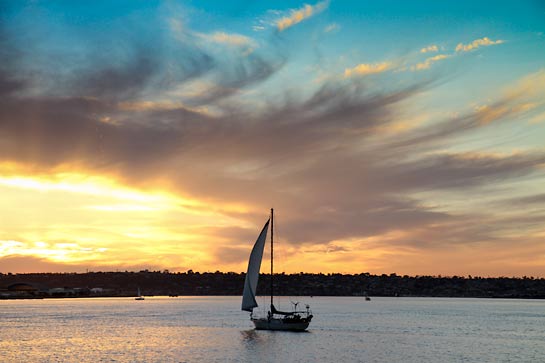
Back on shore, the view from our table at Anthony’s Seafood Grotto, enjoying Happy Hour after a productive day.
All in all it was a delightful and satisfying day, the kind that reminds me why I pay the high price to live in San Diego. And, as always, I came out of this trip having learned some lessons, and if I follow my own advice I’ll be a better photographer next time.
———
(If you’d like to see a larger photo set from this trip, view it here. The gallery was created with one click as a Lightroom export. For details see my Lightroom Training Course.)
As always, my Amazon links are affiliate links, so if you buy any gear from them, you buy me a beer, and you help me create more free tutorials!
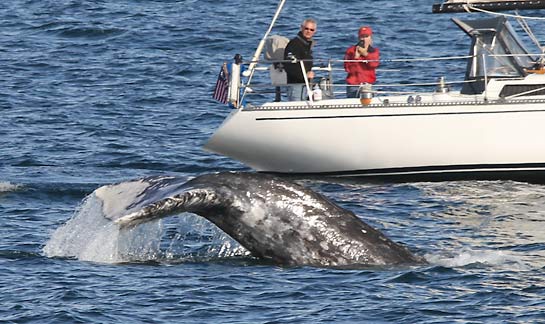
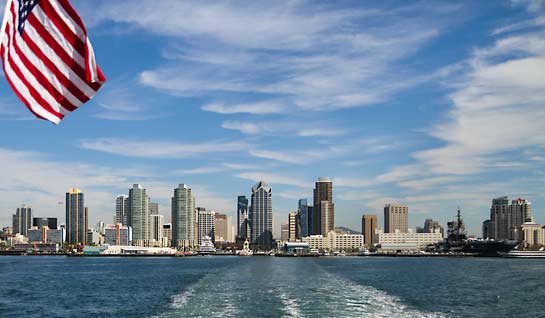
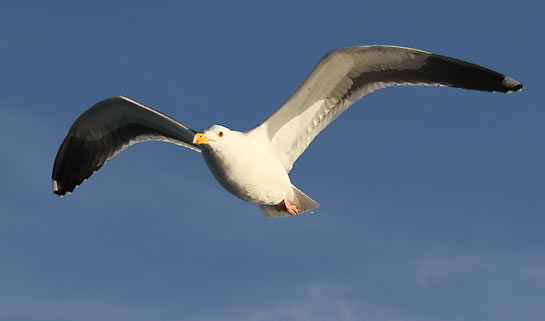
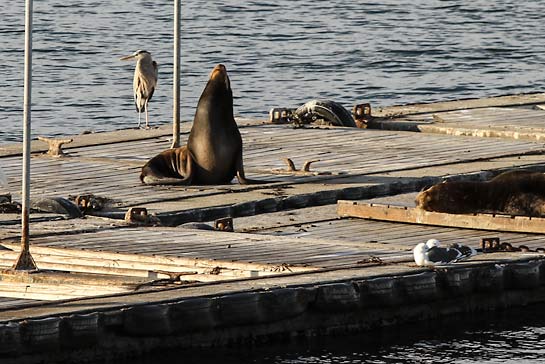
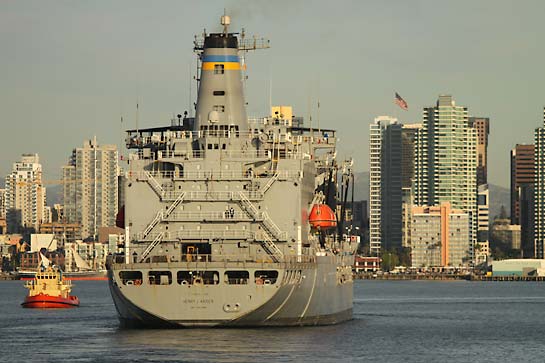
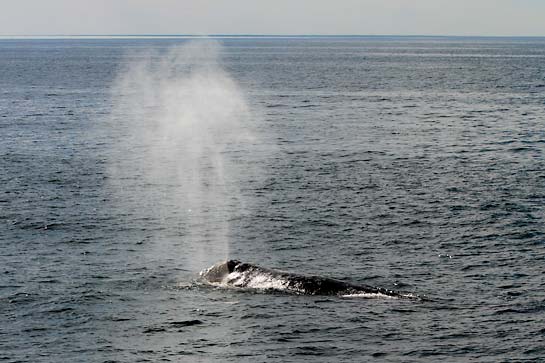
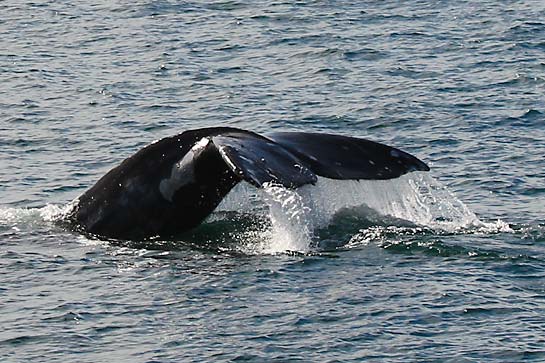
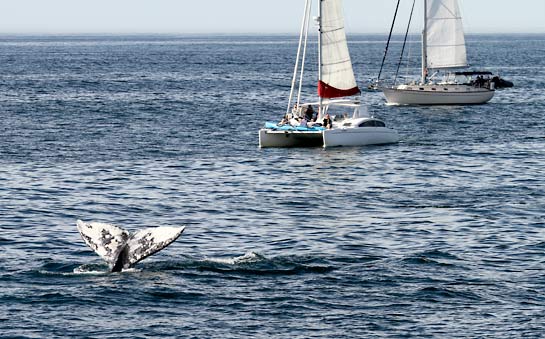
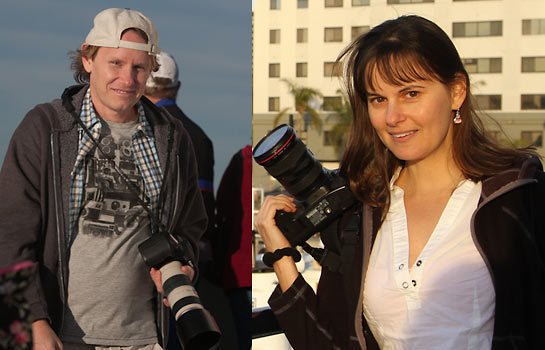



Hey Phil – nice shots and great post!
You are bringing back a lot of memories from my dolphin/whale research days.
I mostly had Humpback Whales not Gray Whales.
I would recommend a teleconverter on a prime lens rather than 70-200mm – I’m planning on hiring a 300mm or 400mm prime telephoto and testing the image quality in the next month – I’ll let you know how it goes 🙂
Ken, of course you’re right, a prime lens would get better results. Let us know how your super-telephoto shooting goes!
Fabulous Photos Phil. I just purchased a 75-300mm Lens. I love it!!
Nice write up about your trip and good reminders (I also have recently forgotten my polarizer). Wish I would have known about Julie’s business last year. I just vacationed there. Whales are always tricky but, you have some nice shots.
What great shots you got Steve. Thanks a lot for sharing.
PS Did you undertake much post shooting editing on say Lightroom (apart from cropping I guess).
Regards
Mike
@Mike Grehan – The post-production was very “quick and dirty” because I needed to condense over 700 photos into a handful for a blog post, and then write the blog post, all in one day. So I did some quick editing in Lightroom (cropping always, some adjustments to exposure and color). Sharpened in Photoshop before publishing. The WordPress blog sometimes degrades the quality of uploaded images to a frustrating degree, but I’ve found that if I save them at a JPG quality of less than 50% from Photoshop, then the blog forces less of its own compression on it, so I end up with a better looking image on the site by saving at lower quality!
Interesting write up Phil; wish we had such interesting subjects within easy reach here in the UK! Going out on the sea here at the moment would require ski gear rather than shorts! Two qu’s – Am thinking of getting the 70-300 L f4-5.6 for my 7D; have you shot that lens, and how does it compare to the 70-200? Also, that variND filter’s the one you took a preliminary look at on the blog – is it a keeper?
Thanks, Phil!
I have a question regarding the ND filter. I thought I had read somewhere that a Circular Polarizing Filter could do double duty and eliminate the need for the ND. Any thoughts on that?
Always appreciate your insights,
r
@Randall – You’re right, there is a lot of similarity in the function of a polarizer and ND filter. With a polarizer you lose some light, so you already have perhaps a 1 stop ND effect. But if you need more stops of light reduction, a true ND is required. And sometimes you may not want the polarizing effect, so a pure ND would be required. But in many cases a polarizer makes a good mini-ND filter.
I shot for years with a 1.4 teleconverter on my Canon 70-200f4 and the pix were great, there’s a newer model now which should be even better. After a lot of my gear was stolen I got a 100-400 f4 instead which is REALLY heavy, but I love it with my 5DII so I just take a Trek-Tek monopod along. With the rare earth magnet quick release it’s a no-brainer to get it on and off in a flash.
@Olie L – Funny, I just had an email from a photographer showing me his great shots with the 70-300 f/4 L on his 5D and 7D. It looks great! If I didn’t already own a telephoto, I’d probably buy one. So far I’m pleased with the variND, but I’ve mostly used it for video where my quality needs are less demanding, so I haven’t given it the hardest testing.
Hi Phil,
Thank you so much for sharing this adventure. You made me look good with my wife because just like you I seem to have problem with “jumping” things and never seem to have them in focus…..Glad to see that even the pros have issues…LOL!
Best regards,
Cheers!
Awesome shots Phil! I have just purchased a 70-300L f4 for my 7D and I like it thus far.
Thanks Phil, you know what?! I really appreciate your honesty, and also the fact the you’re not like “my canon 1Dx and my 400 prime were perfect for the job” you are continually teaching me that you don’t need the best of the best to take amazing photos. At the moment I’m still plugging away with my 500d and a Tamron 24-70mm sp vc, I want to advance to the 5d iii and I also particularly like the 70-200 f4 IS, but that will come later (when my wife lets me, or post marriage). You’ve taught me that composition and subject matter are no. 1. Keep up the great work. Your an inspiration to the under dog!
phil and julie
great job your post was very helpful
i always need to make a check list for my adventures
but mother nature -weather – or some other freak of nature some how screws up the shoot
but the good thing about this and i dont know how
i land some of my best pics ever
again thanks for all your info and you have alot of loyal followers here in lancaster pa. you are a fantastic mentor
wayne
Nice shots. A couple of years ago I used my Canon 50d with a Canon 70 to 300mm L lens to get a lot of humback whale shots off the south eastern coast of Australia. I found it important to shoot fast with a single focus point on the whale and to take lots of photos.
Also as we were following a playful whale, I was helped by anticipating very roughly where the whale might appear next and pre-focusing at that range so the lens locked on quickly. I have found that the lens can be slow to focus or fail to lock on if too far out of focus.
Some of the images are at http://www.flickr.com/photos/lbdphotos/sets/72157627258344473/
Wow, Graeme, you got a crazy dancing whale! Maybe I should have been dropping caffeine tablets overboard…
My main lens is a Nikon 70-200 f/2.8 with a 1.7 converter for whale photos (humpbacks here in New England) plus I have a second camera with a 35-70 mm lens for when the whales come in close to the boat. I like your idea of a ND filter and will also carry my vd filter with me
Great work!
You just reminded me to take my polarizing and ND’s with me.
Nice shost! Thanks for sharing. I will now be getting both an ND and polarized filter soon for my new Canon 6D.
On a sunny day with you moving on a boat boat with jumping whales I assume you need at least 1/500 for shutter speed. Is that correct?
HI Phil,
I enjoyed your article and photos. The best part for me is your honesty and humility. It is refreshing. I like how you focus on how learning is lifelong with photography. Thanks for sharing this very interesting outing.
What timely info. I am headed for a seaside vacation next week and, just today, packed my circ polarizers and an ND. Your terrific blog just verified the importance of them.
The information you relayed in the interesting story really helps me to understand and, hopefully, retain the info.
Thanks.
Great post Phil. I think the challenge with whale photography is always to be able to judge the estimate real life size of a whale. Do you use the 70-200 F4 IS for portraits as well? I am contemplating this lens, but want to make sure it’s going to give me enough DOF for portraits…thank you.
I loved your blog Phil – especially your description of your dolphin photos! I have hundreds just like that and you wouldn’t believe how many I have of grainy, crappy whale water spouts from a distance of 500 metres (with a couple of disappearing tails thrown in for good measure). I thought only us amateurs did stuff like that 🙂
@Nicky van Rooi – Yes, that 70-200 is also one of my favorite portrait lenses (you see me use it a lot in my flash portrait course). As for getting a shallow DOF it’s awesome at f/4 and long zoom. Here’s a sample with that lens (if the link will work):
http://on.fb.me/WajWvX
Great Photos Phil. I think this is some tough shooting (rocking boat, moving whale, and bright colors) and that’s tough to get a lot of detail. Thanks for sharing your lessons learned. Not many people are willing to do that and it says a lot about you for sharing that. As a result, I’d probably rent a 600mm lens without the tele-convertor on a monpod. I take photos in Botswana and have been very happy with a 200-400mm and 600mm lens mounted on my D800. BTW, your Lr and Ps tutorials are great! Thanks, glen
Glen W, thanks for the kind words about my courses. I think you’re right. After seeing the limitations of a 200mm lens at these distances, I think if I went again I’d rent a 400mm or 600mm super telephoto and put it on the full-frame 5D camera. Bonus: I’d rather take a rented lens out in the salt air than one of my own.
Great stuff Phil and Julie. Nice story-line as well. I had no idea you were in the SD area and would have looked you up. Was right there on India St. many times. I live in Lodi and have made 11 trips down there since Oct of 2011 having a Navy reunion and doing some volunteer work on the USS Midway Museum for a few of those trips. If you look at the front of the island structure on the carrier you’ll see a large yellow “E” (Battle Efficiency) and a set of wings with crossed anchors (Aviation Boatswain Mate) painted on nearly 11 foot wide. I designed and painted those on back in May of last year. I actually served on her back in 81-84. Get some good shots and make me proud…ha!
Anyway, I’ll have to look you up next time I come down…but onto the subject at hand. I took a whale watching cruise in Monterey about 6 years ago. It was in June and the Humpbacks were around. We saw several types of dolphins, birds, sea lions, otters and what-not out there and got some neat stuff of them. I was just hoping to see a whale and get a tail shot or two. What I got was actually several tail shots, breathing spout blasts and 4-5 full breaches. I had my 40D and 100-400 at the time. It was overcast and on the gray side that day but pretty nice out weather wise. Once everyone on-board saw what I had and was trying to seriously capture…they all gave me full range of movement and were extremely curtious. It was great. I will have to dig out those CD’s one of these days and send you some shots.
One came so close to our boat (less than 40′) that it wouldn’t all fit in the lens. That same tour outfit had another boat out there that day as well and I got a full breach of one about 25′ off the side of their boat. I showed the pics to the tour owner of what I had when we got back to the pier and he wanted to use them for advertisement. In exchange he offered me and my fiance and a few friends a free return tour. I haven’t made it back down yet. I am a drag racing photographer and consider myself pretty darn fast when it comes to reacting, but it is very difficult to predict just where these creatures will come shooting out. My head was like an owl and my eyes like a spinnig top all the while but it sure was a blast. I did use just a center point for focus and only a UV filter, but will bring other filters next time.
Speaking of dolphin pods…i’ll have to find some old film pics from back in the day out in the Indian Ocean. On a few ocassions we ran across them. Only there were not just a few hundred. There were thousands upon thousands. I’m not talking mega, i’m talking “Super Mega”…No lie. My job was on the flight deck and from it, as far as the eye could see, all the way to the horizon, was this massive pod of dolphins. We all wanted to jump in and play with them. It was a beautiful site to see and was simply amazing. We never saw many whales, but did come across a few packs of Killer Whales during my three years at sea.
We were home ported in Japan so we were down in the South Pacific and IO quite often. Lots of sea life down there. Wished I had an underwater setup when I was snorkeling down in the Philippines. That was incredible. There are lots of things to see out in the water. Flying fish are quite common throughout and are fun to shoot as well, but get much bigger in the colder Northern Pacific and Artic waters.
I now have switched over to Nikon and will have to make another trip out one of these days when I get the time. We’ll have to get together sometime and do some shootin’. Once again great stuff and good huntin’.
YB–Nitro
Phil I read with interest re the IS mode 1& 2 and you choosing 1 over 2 . I’ve yet to find a satisfactory explanation of the difference between the two . Would you mind explaining please. ( I have 70-200 2.8 Canon lens as my regular )
Thanks
Chris
Chris, it’s my understanding that Mode 1 tries to reduce all motion, while Mode 2 allows for panning, by trying to reduce motion along the axis that is most steady. I pretty much always leave it in mode 1 (even when panning, because I forget!)
Another great bolg – useful and personal from a common sense point. You have a unique talent for making the point that you don’t need mega expensive kit to get good photos. It puts the perceived “out of range” in range for us mortals.
Yes she does look good doesn’t she.
Hi Phil, many useful and interesting tidbits in your blog. One more thing I would like to suggest if I may. At end of the seaouting I would make sure that any salt particles are removed from the camera body and the lens. Thanks again for sharing your knowledge and experiences. Nicola Fiscarelli.
Phil, great snaps I must say..:)
loved your article, wish I had it before I shot these back in 2010. Please give me your opinion on the shots, I’m a novice photographer at best. Thanks!
https://www.facebook.com/media/set/?set=a.1728387885440.2099521.1110743023&type=1&l=36e1981091
I had to laugh while reading this. You sound just like me and my photo-friends. There are four of us that get out as often as our four schedules and weather will allow for photography adventures. We are always looking for something new and one of the first things one of us will almost always do once we get home, is fire off an Email of all the things we need to remember for the next time we try that type of trip. We have all kinds of check lists and how-to notes. I don’t know if you have ever tried an app called Evernote but it is awesome for keeping up notes and lists. It is a phone app that has a desktop version and an online version. You can update notes from any one of the versions and they all stayed synced with each other.
And what a cool trip. Now I have to figure out how to get to San Diego!
@Nicola, thanks for the reminder to clean the camera.
@ Joe – Great photos! I wish we had whales breaching like that. You could probably brighten them up a bit in post production to make them even more eye catching.
@Lisa – I have friends who are always recommending Evernote to me. I just have a hard time taking to new habits of note keeping (old dog, new tricks, etc.) But it sounds like something worth trying.
Well, it took me awhile to get around to looking at your photos but I’m glad I finally did. Lucky you to live so close to go whale watching. As for the tips, thanks. I’ll keep those things in mind. I always feel like such an idiot when I forget stuff that that so it really helps when I know even professionals forget to take along things on some shots.
Tks Phil, everytime I read your reports and watch your videos, I am ready to get out and start shoot with the new suggestions.
Since I am planing to visit San Diego this year, can you tell me where to rent Lenses in San Diego.
Tks
@Andy – George’s Camera had rentals. There are also places that you can rent from online, but you pay extra for shipping of course.
I recently took a whale-watching trip out of Newport Landing, and I’m happy to say that I had (somewhat) of the same thought process as you did. And the same equipment. Means I’m growing as a photographer! Thanks for all you do for us amateur and passionate newbies!
I’m definitely going to try one of the photography tours next time I’m in San Diego!
Cindy, Long Beach.
Phil,
You mentioned burrowing and testing a teleconverter. Did you ever do that and if so, what were the results? I too use a 70-200 f4 and go back and forth re. which one to purchase if any.
Mick
Great post and great shots! I’m thinking of buying one of the 70-200mm lenses… hard decision, f4 or f2.8….
Thanks for sharing this.